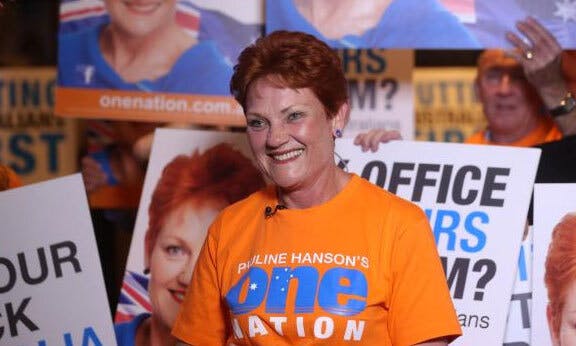The odious spectre of Hansonism is reborn

It’s a shock, but no surprise, that Australia’s most well-known racist politician is back in the national parliament: Pauline Hanson looks certain to become a senator for Queensland following the 2 July election.
Hanson was first voted into parliament 20 years ago, as voters dumped the discredited Labor government of Paul Keating after 13 long years of austerity and privatisation, and John Howard swept into power.
For those who have grown up since that time, it’s sometimes hard to explain what an impact Hanson had, as one of the key figures who made openly racist speech “respectable” in Australian political life from the mid-1990s.
Since the early 1970s, anti-racist struggles and the need to manage a working class drawn from across the world had given rise to a bipartisan consensus in Australia. The structures of racism remained largely unchallenged, condemning Aboriginal people to continuing dispossession and an early death, while most migrants occupied the lowest rungs on the employment ladder. However, openly racist speech was not encouraged among our ruling political elite.
Pauline Hanson broke this pattern. After making a string of racist remarks and being dumped by the Liberal Party, Hanson was elected as an independent candidate for the safe Labor seat of Oxley, west of Brisbane, which included both rural areas and depressed former industrial zones.
Hanson’s maiden speech in parliament denounced the privatisation of Qantas and Telstra, and the destruction of decent jobs, but focused the legitimate anger about this against shadowy enemies in the “financial elites”, and especially against Aboriginal people and Asian migrants.
She denounced “the privileges Aboriginals enjoy over other Australians”, fumed that migrants from the rest of Asia “have their own culture and religion, form ghettos and do not assimilate”, and echoed the words of former Labor leader Arthur Calwell:
“Japan, India, Burma, Ceylon and every new African nation are fiercely anti-white and anti one another. Do we want or need any of these people here? I am one red-blooded Australian who says no and who speaks for 90 percent of Australians.”
This was only the start. Hanson’s 1997 book The Truth predicted that by 2050 Australia’s president would be a lesbian cyborg of Chinese-Indian origin called Poona Li Hung.
Accorded celebrity status by the Murdoch press, Hanson achieved a prominence that encouraged every racist to crawl out from under their rock. Friends of mine who had lived their whole life in Melbourne were now being told on trains to “go back to where you come from” on the basis of their brown skin.
Liberal prime minister John Howard applauded all this as an outbreak of “free speech”, and used the celebrity status of Hanson to justify racist policies that distracted and divided us while he rammed though attacks on workers. Quite a number of ideas that emerged as Pauline Hanson thought bubbles, such as temporary protection visas and turnbacks of refugee boats, became government policy over the months and years that followed.
Labor ducked for cover from Hanson. However, the far left was able to organise against a Hanson speaking engagement in Melbourne in 1998. The event was cancelled after thousands of us surrounded Hawthorn Town Hall and shut the meeting down.
“MOB HALTS HANSON”, blared the next day’s papers. Lively rallies in Dandenong and Geelong also shut down pro-Hanson meetings. These direct confrontations with the racists prevented Hanson from cohering her support into a national political machine and started to dent seriously her standing in the polls.
This wasn’t her only problem. Once the political establishment had used her to break the consensus against racist political speech, they turned on her. By the early 2000s, Hanson was reduced to the status of a B-grade political has-been, serving three months in jail for electoral fraud and featuring in the opening series of Dancing with the Stars.
Her re-emergence as a serious political force is based on sheer political persistence and mainstream media fawning – she is regularly courted for her bigoted views by TV shows such as Channel 7’s Sunrise. But it is the anti-Muslim racism of mainstream media and politicians over many years that has provided the wind beneath Hanson’s racist political wings. The sort of speech for which Hanson was rightly condemned 20 years ago has now become so mainstream that it is hardly noticed.
Back in 1996, Hanson was the harbinger of a new, racist turn in Australian political life. Today, she’s dropped most of her rhetoric against Aboriginal people and Asians, and rails almost exclusively against Muslims.
Just as in the 1990s, the presence of an organised far right force in the national parliament will be used by mainstream politicians to justify moving further, and faster, in a racist direction. And just like in the 1990s, how far this racist push goes depends a lot on how effectively our side can organise against it.